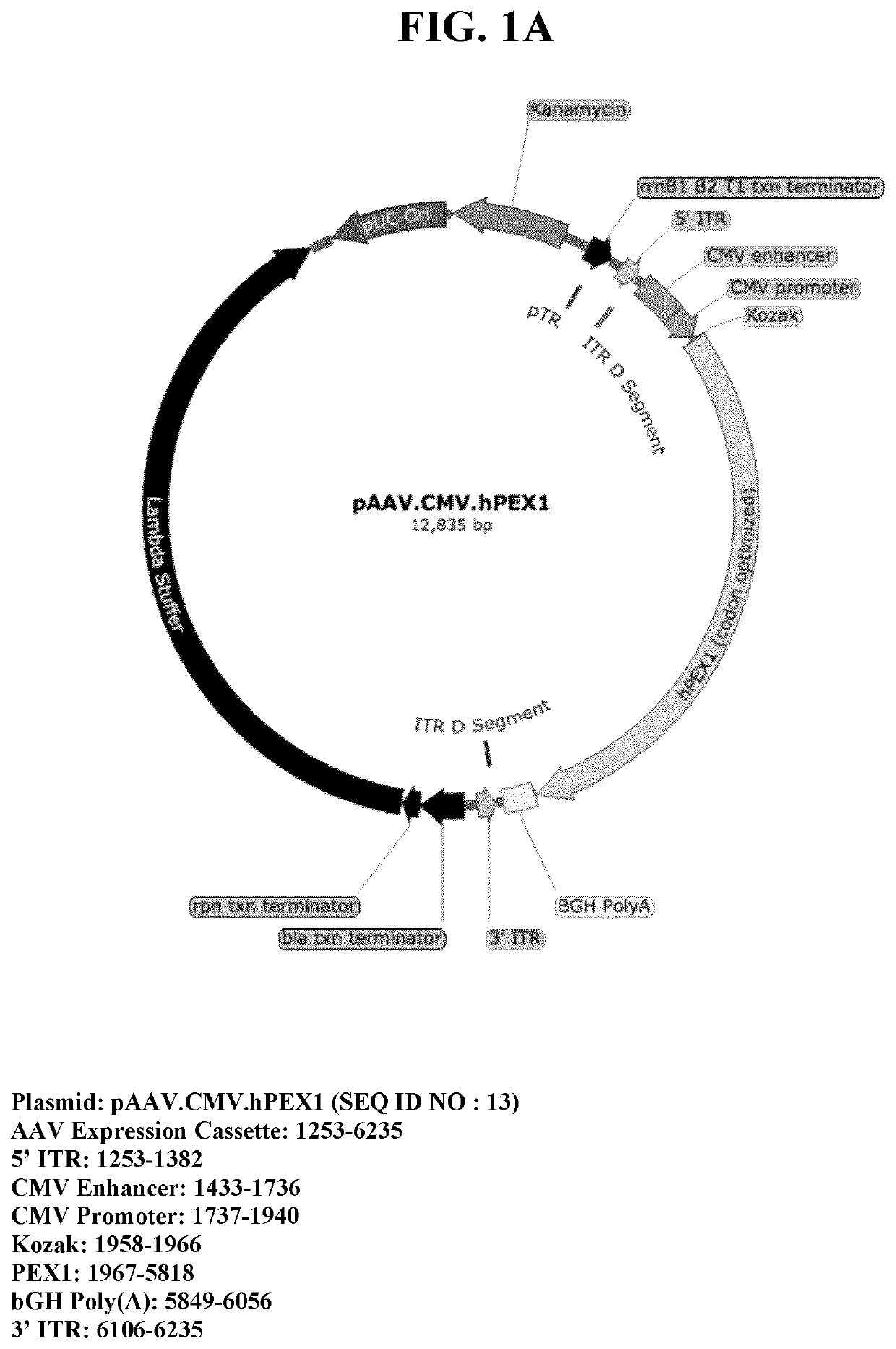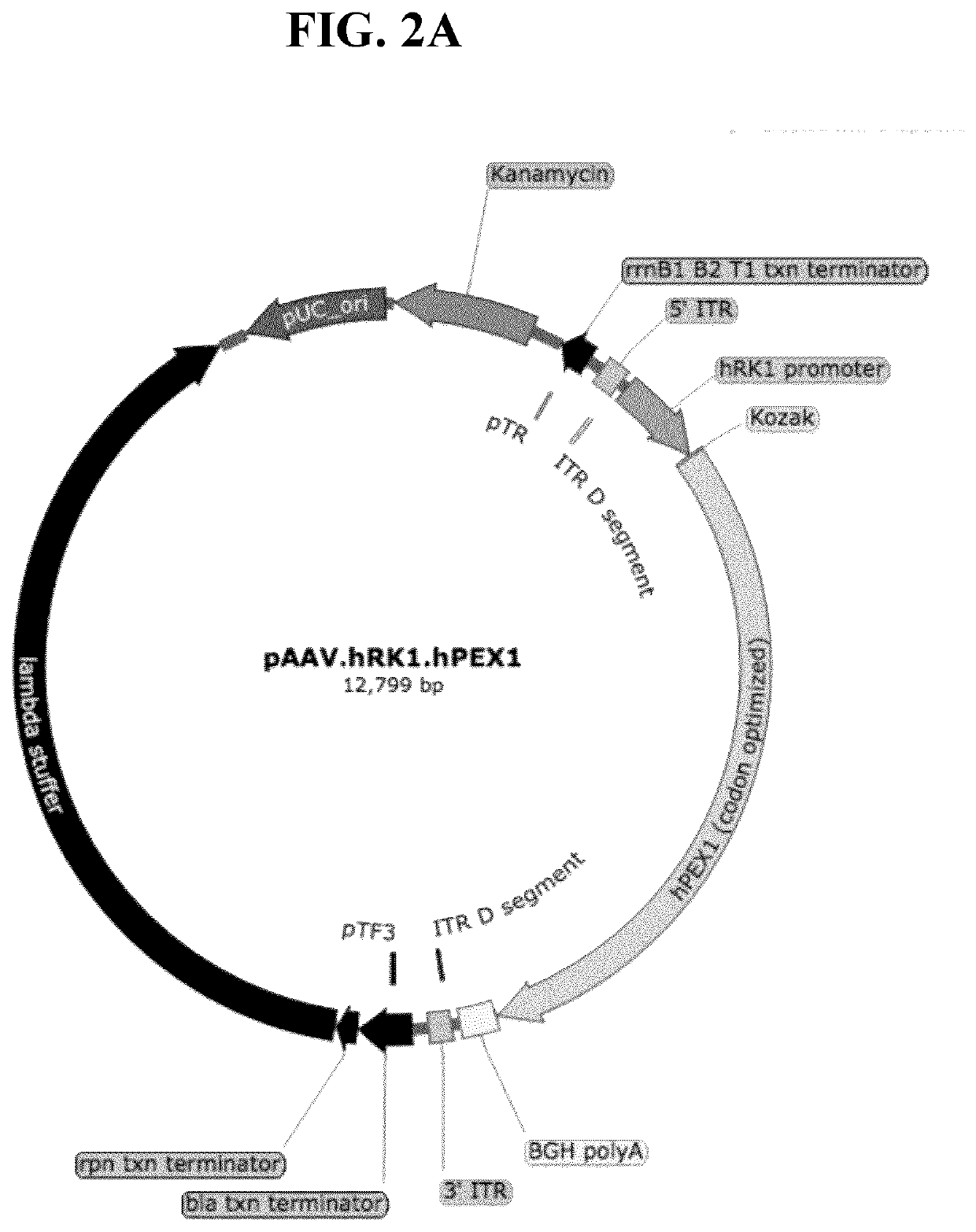Gene therapy for treating peroxisomal disorders
- Summary
- Abstract
- Description
- Claims
- Application Information
AI Technical Summary
Benefits of technology
Problems solved by technology
Method used
Image
Examples
example 1
Generation of AAV.hPEX1 Vectors
[0170]Viral vectors capable of delivering PEX1 to diseased tissue, including retinal cells in the eye, were generated. This vector could be used to treat disease classified as Zellweger syndrome, infantile Refsum disease and neonatal adrenoleukodystrophy. Results indicate that delivery of a recombinant adeno-associated virus (AAV) containing the human PEX1 cDNA (AAV.hPEX1) to tissue of mice lacking Pex1 corrects the disorder and that delivery of AAV.hPEX1 to affected cells in vivo could potentially ameliorate or even cure the disorder.
[0171]One of the challenges of delivering PEX1 using AAV is that the cDNA is large (3852 bp). Because of the limited cargo capacity of rAAV vectors (4.8 kb), small regulatory sequences were incorporated into the proviral plasmid. These included a cytomegalovirus (CMV) promoter, a chicken beta actin (CBA) promoter and a rhodopsin kinase promoter, thereby generating pAAV-CMV-hPEX1 (FIG. 1A, SEQ ID NO: 6) and pAAV-hRK1-hPEX1...
example 2
Summary of rAAV Mediated PEX1 Gene Augmentation
[0175]Optical coherence tomography (OCT) demonstrated that the cone photoreceptor cells were most significantly affected by loss of peroxisome functions in patients described herein. These visual phenotypes were recapitulated in a knock-in mouse model (indicated as Pex1G844D, Pex1G844D, Pex1-G844D, or Pex1-mutant mice) of the milder form of the disease that expresses the murine equivalent of most common PEX1 mutation found in patients (PEX1-p.G843D). Baseline retinal function was evaluated with electroretinograms (ERGs). D. Zack et al demonstrated a severe impairment of the cone visual pathway in these homozygous Pex1-mutant mice by 4 months of age with the rod visual system being relatively preserved. See, Hiebler, Shandi, et al. “The Pex1-G844D mouse: a model for mild human Zellweger spectrum disorder.” Molecular genetics and metabolism 111.4 (2014): 522-532.
[0176]Studies in the homozygous Pex1G844D mouse were performed to determine w...
example 3
rAAV Mediated PEX1 Gene Augmentation Improves Visual Function in a Mouse Model for Zellweger Spectrum Disorder (ZSD)
[0177]Zellweger Spectrum Disorder (ZSD) is a peroxisome biogenesis disorder. Diagnosis is usually made in infancy after patients present with weak muscle tone and delayed physical development, (Steinberg SJ, et al. Peroxisome Biogenesis Disorders, Zellweger Syndrome Spectrum. In: Pagon R A, et al., editors. GeneReviews(R). Seattle (WA)(1993)) and vision and hearing defects become apparent later in childhood. Mutations in peroxin or peroxisomal biogenesis factor (PEX) genes and consequent PEX protein deficiency prevent normal peroxisome formation. This leads to defects in lipid metabolism and waste degradation. Treatments are supportive, but no cure is available.
[0178]Given recent successes in preclinical models and in human clinical trials evaluating gene augmentation therapy, there is hope that a gene augmentation approach can be applied to treat ZSD. One of the tissu...
PUM
| Property | Measurement | Unit |
|---|---|---|
| Fraction | aaaaa | aaaaa |
| Fraction | aaaaa | aaaaa |
| Fraction | aaaaa | aaaaa |
Abstract
Description
Claims
Application Information
 Login to View More
Login to View More - R&D
- Intellectual Property
- Life Sciences
- Materials
- Tech Scout
- Unparalleled Data Quality
- Higher Quality Content
- 60% Fewer Hallucinations
Browse by: Latest US Patents, China's latest patents, Technical Efficacy Thesaurus, Application Domain, Technology Topic, Popular Technical Reports.
© 2025 PatSnap. All rights reserved.Legal|Privacy policy|Modern Slavery Act Transparency Statement|Sitemap|About US| Contact US: help@patsnap.com



